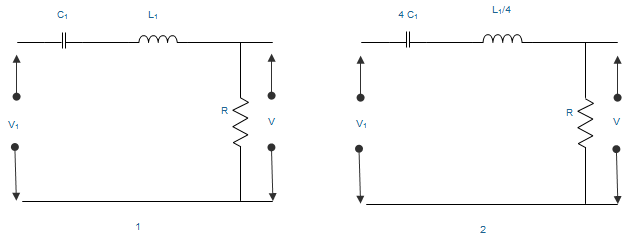This set of Signals & Systems Multiple Choice Questions & Answers (MCQs) focuses on “Applications of Signals on Circuits”.
1. A circuit tuned to a frequency of 1.5 MHz and having an effective capacitance of 150 pF. In this circuit, the current falls to 70.7 % of its resonant value. The frequency deviates from the resonant frequency by 5 kHz. Q factor is?
a) 50
b) 100
c) 150
d) 200
View Answer
Explanation: \(Q = \frac{ω}{ω1 – ω2} = \frac{f}{f2-f1} \)
Here, f = 1.5 × 106 Hz
f1 = (1.5 × 106 – 5 × 103)
f2 = (1.5 × 106 + 5 × 103)
So, f2 – f1 = 10 × 103 Hz
\(∴ Q = \frac{1.5 × 10^6}{10 × 10^3}\) = 150.
2. A 440 V, 50 HZ AC source supplies a series LCR circuit with a capacitor and a coil. If the coil has 100 mΩ resistance and 15 mH inductance, then at a resonance frequency of 50 Hz the half power frequencies of the circuit are ______________
a) 50.53 Hz, 49.57 Hz
b) 52.12 HZ, 49.8 Hz
c) 55.02 Hz, 48.95 Hz
d) 50 HZ, 49 Hz
View Answer
Explanation: Bandwidth, BW = \(\frac{f_o}{Q} = \frac{50}{47.115}\) = 1.061 Hz
f2, higher half power frequency = f0 + \(\frac{BW}{2}\)
∴ \(f_2 = 50 + \frac{1.061}{2}\) = 50.53 Hz
f1, lower half power frequency = f0 – \(\frac{BW}{2}\)
∴ f1 = 100 – \(\frac{1.59}{2}\) = 49.47 Hz.
3. The even component of the signal Y (t) = ajt is _________________
a) Sin t
b) Cos t
c) Sinh t
d) Cosh t
View Answer
Explanation: Let Ya (t) represents the even component of Y (t)
Now, Ya (t) = \(\frac{1}{2}\)[Y (t) + Y (-t)]
= \(\frac{1}{2}\)[ajt + a-jt]
= cos t.
4. The odd component of the signal Y (t) = ajt is _______________
a) Sin t
b) Cos t
c) Sinh t
d) Cosh t
View Answer
Explanation: Let Yo (t) represents the odd component of Y (t)
Now, Yo (t) = \(\frac{1}{2}\)[Y (t) – Y (-t)]
= \(\frac{1}{2}\)[ajt + a-jt]
= sin t.
5. The signal Y (t) = e-2t u (t) is _______________
a) Power signal with P∞ = \(\frac{1}{4}\)
b) Power signal with P∞ = \(\frac{1}{2}\)
c) Energy signal with E∞ = \(\frac{1}{4}\)
d) Energy signal with E∞ = 0
View Answer
Explanation: If a signal has E∞ as ∞ and P∞ as a finite value, then the signal is a power signal. If a signal has E∞ as a finite value and P∞ as ∞, then the signal is an energy signal.
|Y (t)| < ∞, E∞ = \(\int_{-∞}^∞ |y(t)|^2 \,dt\)
= \(\int_∞^∞ e^{-2t} u(t) \,dt \)
= \(\in_∞^∞ e^{-2t} \,dt = \frac{1}{2}\)
So, this is not a power signal but an energy signal.
\(P_∞ = lim_{T→∞} \frac{1}{2T} \int_{-T}^T |y(t)|^2 \,dt = ∞.\)
6. The signal X (t) = \(e^{j(2t + \frac{π}{4})}\) is ________________
a) Energy signal with E∞ = 2
b) Power signal with P∞ = 2
c) Power signal with P∞ = 1
d) Energy signal with E∞ = 1
View Answer
Explanation: If a signal has E∞ as ∞ and P∞ as a finite value, then the signal is a power signal. If a signal has E∞ as a finite value and P∞ as ∞, then the signal is an energy signal.
|x (t)| = 1, E∞ = \(\int_{-∞}^∞ |x(t)|^2 \,dt = ∞\)
So, this is a power signal not an energy signal.
\(P_∞ = lim_{T→∞} \frac{1}{2T} \int_{-T}^T |x(t)|^2 \,dt = 1.\).
7. Given the signal
Y (t) = cos t, if t>0
Sin t, if t≥0
The correct statement among the following is?
a) Periodic with fundamental period 2π
b) Non-periodic and discontinuous
c) Periodic but with no fundamental period
d) Non-periodic but continuous
View Answer
Explanation: From the graphs of cos and sin, we can infer that at t=0, the function becomes discontinuous.
Since, cos 0 = 1, but sin 0 = 0
As 1 ≠ 0, so, the function X (t) is discontinuous and therefore Non-periodic.
8. Two series resonant filters are shown below. Let the cut-off bandwidth of filter 1 be B1 and that of filter 2 be B2. The value of \(\frac{B_1}{B_2}\) is ____________

a) 0.25
b) 1
c) 0.5
d) 0.75
View Answer
Explanation: For series resonant circuit, 3dB bandwidth is \(\frac{R}{L}\)
B1 = \(\frac{R}{L_1}\)
B2 = \(\frac{R}{L_2} = \frac{4R}{L_1}\)
Hence, \(\frac{B_1}{B_2}\) = 0.25.
9. In a series RLC circuit for lower frequency and for higher frequency, power factors are respectively ______________
a) Leading, Lagging
b) Lagging, Leading
c) Independent of Frequency
d) Same in both cases
View Answer
Explanation: A Leading power factor means that the current in the circuit leads the applied voltage. This condition occurs in capacitive circuits. On the other hand, a lagging power factor indicates that current lags the voltage and this condition happens in an inductive circuit.
10. A series RLC circuit has a resonance frequency of 1 kHz and a quality factor Q = 50. If R and L are doubled and C is kept same, the new Q of the circuit is ____________
a) 25.52
b) 35.35
c) 45.45
d) 20.02
View Answer
Explanation: Quality factor Q of the series RLC circuit is given by, \(Q = \frac{1}{R} \sqrt{\frac{L}{C}}\)
Given that Q = 50
Qnew = \(\frac{1}{2R} \sqrt{\frac{2L}{C}}\)
= \(\frac{1}{2} × \frac{1}{R} \sqrt{\frac{2L}{C}}\)
= \(\frac{1}{2} × \sqrt{2} × Q \)
= \(\frac{1}{2} × \sqrt{2}\) × 50 = 35.35.
Sanfoundry Global Education & Learning Series – Signals & Systems.
To practice all areas of Signals & Systems, here is complete set of 1000+ Multiple Choice Questions and Answers.
If you find a mistake in question / option / answer, kindly take a screenshot and email to [email protected]
